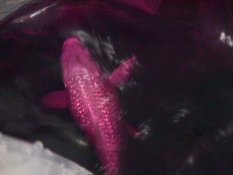
KMnO4: Potassium Permanganate for Parasites and Bacteria in Fish
Potassium Permanganate Basics
Written by Dr Erik Johnson
Potassium permanganate is perhaps my favorite in the treatment of Koi. This is a big change from four years ago when I suggested folks leave this one alone. It’s a very powerful medicant which can kill fish if not respected.
Potassium is a granular powder which turns the water purple during it’s effect. It oxidizes organic material, including the surfaces of bacterial sores (ulcers) and the parasites that cause them. Once it’s spent it’s energy on the pond and parasites, the potassium turns amber or brown and can be removed with a water change or with hydrogen peroxide (3% USP) – See peroxide information below.

Potassium permanganate is applied at the rate of one gram per one hundred gallons or one level teaspoonful per six hundred gallons. I use 8 level teaspoonsful in my 4800 gallon pond.
Once the potassium has turned Amber or brown, I can remove it with a waterchange or with Hydrogen Peroxide (3% USP) –
In case of overdosage or untoward reaction to the potassium, you should be aware that it is INSTANTLY de-activated by De-Chlor (Sodium thiosulfate) or also by Hydrogen peroxide. The neutralizing effects may last three to four DAYS afterwards, inhibiting subsequent treatments.
For best results with Flukes, (parasites of trematode class) you would be well advised to treat for several days, but being sure to apply a final treatment on day four or five. This intercepts any emerging trematodes that may have hidden on the bottom.
Ciliates would require daily treatments without water changes in between, to cover about a week period. Please read the other Potassium permanganate articles in this web site or use the information (whole section) in the book. “Koi Health & Disease 2006 Reload”
Ingredients:
One pound of granular or crystalline potassium permanganate (KmnO4)
One pond, freshly cleaned of debris, bottom-detritus, dead fish or uneaten food.
One group of fish with flashing, red spots, spider web skin lesions, fin rot, sliminess, Ulcers, fungal lesions.
Precautions:
The presence of large amounts of organic debris, uneaten food, dead fish, leaves, dead plants will cause the potassium to spend it’s energy on oxidizing the organics, not on the parasites or ulcers.
The presence of dechlorinator in the water will inactivate the treatment. (Latency 2 days)
The presence of Hydrogen peroxide will inactivate treatment. (Latency 3 days)
Potassium can kill a lot of algae, increasing oxygen demand, especially in warm water over eighty degrees.
How to do this:
Day One
1. Bypass filter but increase circulation and aeration.
2. Apply one level teaspoon of granular potassium permanganate per six hundred gallons of water. Do not stand down wind as the powder is added. Do not get in eyes. Do not get on skin. Do not breathe powder.
3. Wait until water changes from purple/pink into a brown or amber color.
4. Resume filtration and keep up all circulation.
5. Apply standard OTC Hydrogen Peroxide 3% USP at a rate of one quart per five thousand gallons of pond water. In one hour you’ll have clear water with no residual evidence of Potassium staining.
Day Four
1. Bypass filter but increase circulation and aeration.
2. Apply one level teaspoon of granular potassium permanganate per six hundred gallons of water.
3. Wait until water changes from purple/pink into a brown or amber color.
4. Resume filtration and keep up all circulation.
5. Apply standard OTC Hydrogen Peroxide 3% USP at a rate of one quart per five thousand gallons. In one hour you’ll have clear water with no residual evidence of Potassium staining.
Days Eight & Twelve
Exact repeat of Days one and four.
What about flukes which hide in the filter?
If you did one treatment of PP and bypassed the filter, the flukes could hide out in the filter.
If you do the fluke regiment of potassium, which is based on a knowledge of the life cycle of the fluke and knowing that the emerging fluke REQUIRES a meal shortly after birth or hatching, **serial** PP treatments make continued infestation of the filter impossible.
Again, one treatment with filter bypass will spare adults and larvae in the filter, however these must feed, and so will mov into the pond to do so. Three to four days later – before they can reproduce a complete egg-to-egg cycle – you treat again and kill 99% of the ones left. Still, in case one lives in the filter, the third and fourth treatments are final.
Always, if your filter is matched to the pond, bypass it for these treatments.
If you’re over filtering, you can spare the bacteria and needn’t bypass. At your own risk.
Doc Johnson
INDICATIONS:
- Body Ulcers
- Body Fungus
- Slimy fish
- Fin or Mouth Rot
The importance of UV Sterilization in the limitation of bacterial infections in small facilities cannot be over emphasized. I don’t recommend UV in natural or eco system ponds. There’s too much going on as far as equillibrium and UV seldom improves the health of the fish in those. In koi museums where there are no natural microbes, rotifers, copepods, bacterial and plant agglutinins, bacteriophage, etc it might be a good idea to curb unchecked bacteria.
The importance of Ammonia and pH testing in the limitation of any disease cannot be over emphasized.
“If you were going to use Potassium to combat a ciliated protozoan like Ich or something, you would have to hit the parasite every day for at least five days. There are much better ways to control these organisms. ” Doc Johnson
+ Note From Doc Johnson
“If you’re using peroxide to reverse the potassium, you need to know that the peroxide will remain in the water for days. Adding more and more and more potassium will kill your fish. The protocol at right takes the latency of peroxide into consideration.” ~ Doc Johnson
